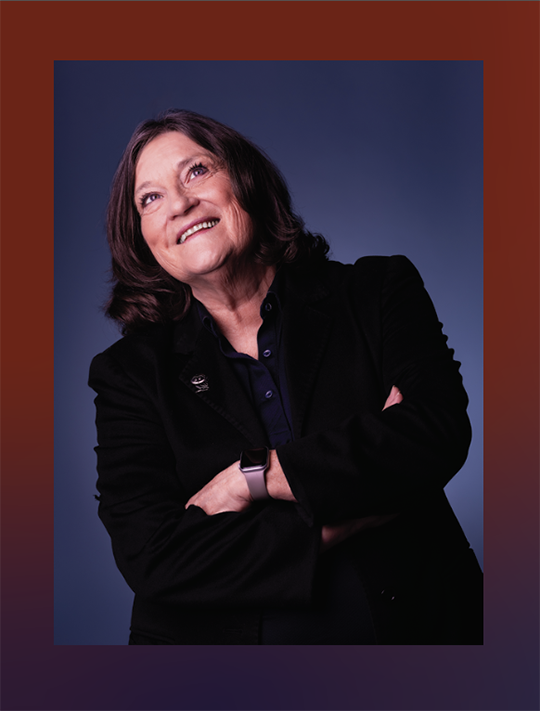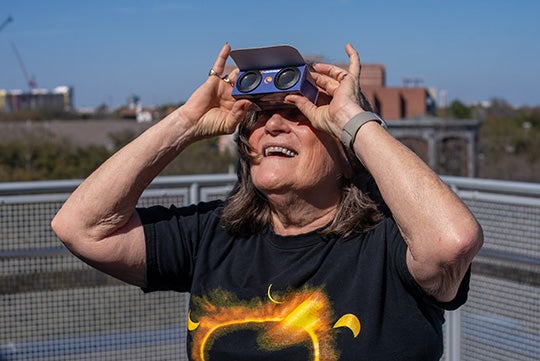Total Eclipse of the Sun
Physicist and alumna Pat Reiff and her citizen scientists are collecting new images of the sun’s corona.

Spring 2024
By Robyn Ross
On the balmy afternoon of April 20, 2023, Pat Reiff ’74, ’75 stood in the courtyard of an Australian resort, poised for action. She and a team of U.S. scientists had traveled to the city of Exmouth on the North West Cape, a narrow peninsula on the continent’s western coastline and one of a few places on Earth that would soon experience a total solar eclipse.
The path of totality — the route the moon’s shadow would take across the Earth’s surface — clipped the tip of the North West Cape before crossing the Timor Sea and parts of Indonesia. For 57 seconds, the moon would completely block the sun, giving the team just enough time to test its equipment. These 57 seconds were worth traveling across the world.
As the moon moved slowly across the sun’s face, Reiff, a professor of physics and astronomy at Rice, felt a surge of adrenaline. This would be her 17th total eclipse, but the experience always engendered a sense of astonishment and awe. The team watched the seconds tick down until the moon fully covered the sun and light drained from the sky. Then they jumped into action, removing the solar filters from three telescopes so they could capture footage of the corona, the sun’s outer atmosphere. Reiff kept one eye on the equipment while she watched her colleagues and the resort staff stare upward, agape, at the apparent void where the sun had been, surrounded by the sparkling wisps of the corona.
The moment before totality ended, Reiff replaced the solar filter so the sun’s intense light wouldn’t destroy the equipment. Everyone exhaled, looking at one another in wonder. After so many eclipses, Reiff later says, “part of the fun is watching other people have that ‘aha’ moment. It is staggering and awe-inspiring, and half of the first-timers end up crying. It’s a visceral thing.”
Total solar eclipses also present a rare and ideal opportunity for scientists to study the corona, which is otherwise difficult to photograph amid the brightness of the sun. The trip to Australia was a test run for the main event: the April 8, 2024, total solar eclipse that will cross the United States from Texas to Maine.
It is staggering and awe-inspiring, and half of the first-timers end up crying.
During that eclipse, the Citizen Continental-America Telescopic Eclipse, or Citizen CATE, will use the equipment tested in Australia — telescopes with attached cameras — to capture images of the corona in polarized light. Thirty-five teams will be spaced along the path of totality, each experiencing between 3 1/2 and 4 1/2 minutes of darkness. Scientists at the Southwest Research Institute, which runs the project, later will stitch the overlapping images into a 60-minute movie that reveals how the corona changed over the duration of the eclipse. Researchers will study the footage to advance their understanding of the corona’s structure.
As the southwest regional coordinator for Citizen CATE, Reiff oversees the 12 teams positioned across Texas and Arkansas. Her role harnesses her scientific expertise as a heliophysicist as well as the relationships she’s built with Texas educators as the associate director for outreach programs at the Rice Space Institute and the leader of Rice’s Master of Science Teaching program.
Although the CATE data is immensely valuable to researchers, the project is also a public outreach tool: The 35 teams are composed not of highly experienced scientists but of high school and junior college students and instructors. The teams have trained to use the equipment and will be assisted by volunteers from local astronomy clubs and community colleges. Reiff’s job was, in part, to publicize the project to her network of more than 10,000 teachers, encourage them to apply, and ensure they were prepared for the project.
Total solar eclipses are a significant part of Reiff’s life. She has led eclipse tours to overseas destinations, developed a solar-filtering screen for safe eclipse viewing, and, with adjunct professor of physics and astronomy Carolyn Sumners, created a planetarium show about total solar eclipses for the Houston Museum of Natural Science.
Although total solar eclipses occur roughly every 18 months somewhere on Earth, the opportunity to see one close to home is rare: The most recent total solar eclipses visible in the contiguous United States were in 2017, when the path of totality crossed the country from Oregon to South Carolina, and in 1979, when the path crossed the Pacific Northwest. The next to sweep across the middle of the country will occur in 2045. But umbraphiles — or eclipse chasers — like Reiff travel the world to see them. April 8 will mark her 18th time in totality. Through the CATE project, she’s also cultivating that sense of cosmic awe in a new generation.

“We want to spread the excitement of total eclipses to more people,” she says. “Kids have a natural curiosity, and when you can pique their curiosity with something that is so outside of their normal experience, you get them hooked.”
Although staff at Southwest Research selected the Citizen CATE teams, they leaned heavily on the recommendations of regional coordinators such as Reiff. They also considered her input as they chose the state coordinators who will closely supervise four sites each. (Reiff’s region has a south and north Texas coordinator and an Arkansas coordinator; each region also has a lead trainer, and Rice graduate student Charlie Gardner serves in that role for the southwest region.)
CATE is specifically designed for underrepresented communities that do not otherwise have access to advanced scientific opportunities or equipment. For instance, Reiff’s territory includes teams comprising students and educators in Eagle Pass; Uvalde; Kemp, southeast of Dallas; and Atkins, Arkansas.
Jennifer Miller-Ray, Reiff’s coordinator for the region stretching from Eagle Pass to the Hill Country, is an associate professor of education at Sul Ross State University who conducts STEM outreach with secondary school students in a vast area of southwest Texas that includes Eagle Pass and Uvalde. She says the predominantly Hispanic area has a rich culture and history but also has needs that are overlooked because of the region’s remoteness. Citizen CATE offers mentorship and equipment — the schools get to keep the telescopes — to students who’ve had fewer opportunities than those in major metro areas.
This is a new, novel data set. Nothing like this has ever been collected before.
“This is providing a way for us to build a sustained program in these communities, beyond the eclipse, to get kids excited about astronomy and topics related to space science,” Miller-Ray says.
Plus, says Citizen CATE project manager Sarah Kovac, the initiative is entrusting the teams with collecting information that’s the first of its kind. “It’s really rare for students to be able to contribute to what is genuinely new, world-class science,” she says. “This is a new, novel data set. Nothing like this has ever been collected before.”
Scientists know relatively little about the middle corona’s structure or about why the corona is hundreds of times hotter than the surface of the sun. But the corona is difficult to study because the sun’s light is so much brighter and makes it hard to see. Researchers can look at outer parts of the corona by using a tool called a coronagraph, a telescope that blocks the direct light of the sun — simulating an eclipse — with an occulting disk. But because the disk needs to appear slightly larger than the sun, to avoid the sun causing harm to the viewer or the telescope, it blocks the innermost part of the corona from view. A total solar eclipse solves these problems because the perfectly sized occulting disk of the moon blocks all light from the sun while allowing scientists to see all parts of the corona.
Even so, total solar eclipses are brief, observable for only a few minutes at any one place on Earth. Because the corona is constantly changing due to the turbulence in its magnetic field, footage obtained at a single location cannot fully capture dynamic events such as a coronal mass ejection, a sudden release of plasma and magnetic field that can last for hours. Citizen CATE will compile images from the entire duration of the eclipse across the country, providing more complete documentation of the evolving corona. Building on a 2017 iteration of the project that captured images in white light, this year CATE’s images will be captured in polarized light, which will reveal information about the three-dimensional structure of the corona and help researchers differentiate among its features. In addition to answering questions about the sun’s corona, the CATE data may help scientists understand the processes that generate space weather, such as solar flares and coronal mass ejections, which can affect the orbit of satellites, radio communication and the accuracy of GPS.
It’s a very ambitious and technically challenging project, but like a lot of good science projects, the more you invest, the more you get out of it.
Two months before the eclipse, Reiff said she felt confident in her citizen scientists. “It’s a very ambitious and technically challenging project, but like a lot of good science projects, the more you invest, the more you get out of it,” she said. “There’s always an element of risk when your teams are not professionals, but I see the enthusiasm and the eagerness to do it right.”
What’s more, she pointed out, once the teams start the equipment at the beginning of totality, a computer will control the telescope. Then the teachers and students can remove their eclipse glasses to focus on the experience that first captivated Reiff more than four decades ago — and that, perhaps, will inspire the next generation to study the sun.
UPDATE: Pat Reiff joined faculty, staff, alumni and friends in Bandera, Texas, for the April 8, 2024, total solar eclipse. Although Bandera was clouded over, Citizen CATE collected data in other locations. For Pat's reports in coming days and weeks, check twitter.com/citizencate2024, twitter.com/patreiff and https://space.rice.edu/citizen_cate/.
